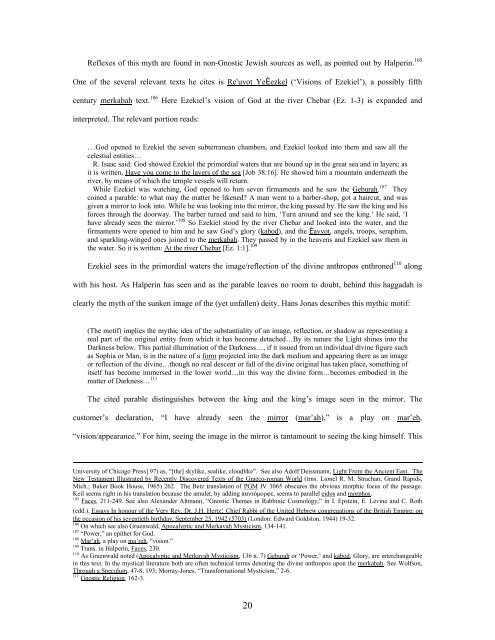Sapphiric God: - Dr. Wesley Muhammad
Sapphiric God: - Dr. Wesley Muhammad
Sapphiric God: - Dr. Wesley Muhammad
Create successful ePaper yourself
Turn your PDF publications into a flip-book with our unique Google optimized e-Paper software.
Reflexes of this myth are found in non-Gnostic Jewish sources as well, as pointed out by Halperin. 105<br />
One of the several relevant texts he cites is Re"uyot YeÈezkel (‘Visions of Ezekiel’), a possibly fifth<br />
century merkabah text. 106 Here Ezekiel’s vision of <strong>God</strong> at the river Chebar (Ez. 1-3) is expanded and<br />
interpreted. The relevant portion reads:<br />
…<strong>God</strong> opened to Ezekiel the seven subterranean chambers, and Ezekiel looked into them and saw all the<br />
celestial entities…<br />
R. Isaac said: <strong>God</strong> showed Ezekiel the primordial waters that are bound up in the great sea and in layers; as<br />
it is written, Have you come to the layers of the sea [Job 38:16]. He showed him a mountain underneath the<br />
river, by means of which the temple vessels will return.<br />
While Ezekiel was watching, <strong>God</strong> opened to him seven firmaments and he saw the Geburah. 107 They<br />
coined a parable: to what may the matter be likened? A man went to a barber-shop, got a haircut, and was<br />
given a mirror to look into. While he was looking into the mirror, the king passed by. He saw the king and his<br />
forces through the doorway. The barber turned and said to him, ‘Turn around and see the king.’ He said, ‘I<br />
have already seen the mirror.’ 108 So Ezekiel stood by the river Chebar and looked into the water, and the<br />
firmaments were opened to him and he saw <strong>God</strong>’s glory (kabod), and the Èayyot, angels, troops, seraphim,<br />
and sparkling-winged ones joined to the merkabah. They passed by in the heavens and Ezekiel saw them in<br />
the water. So it is written: At the river Chebar [Ez. 1:1]. 109<br />
Ezekiel sees in the primordial waters the image/reflection of the divine anthropos enthroned 110 along<br />
with his host. As Halperin has seen and as the parable leaves no room to doubt, behind this haggadah is<br />
clearly the myth of the sunken image of the (yet unfallen) deity. Hans Jonas describes this mythic motif:<br />
(The motif) implies the mythic idea of the substantiality of an image, reflection, or shadow as representing a<br />
real part of the original entity from which it has become detached…By its nature the Light shines into the<br />
Darkness below. This partial illumination of the Darkness…, if it issued from an individual divine figure such<br />
as Sophia or Man, is in the nature of a form projected into the dark medium and appearing there as an image<br />
or reflection of the divine…though no real descent or fall of the divine original has taken place, something of<br />
itself has become immersed in the lower world…in this way the divine form…becomes embodied in the<br />
matter of Darkness… 111<br />
The cited parable distinguishes between the king and the king’s image seen in the mirror. The<br />
customer’s declaration, “I have already seen the mirror (mar’ah),” is a play on mar’eh,<br />
“vision/appearance.” For him, seeing the image in the mirror is tantamount to seeing the king himself. This<br />
University of Chicago Press] 97) as, “[the] skylike, sealike, cloudlike”. See also Adolf Deissmann, Light From the Ancient East. The<br />
New Testament Illustrated by Recently Discovered Texts of the Graeco-roman World (trns. Lionel R. M. Strachan; Grand Rapids,<br />
Mich.; Baker Book House, 1965) 262. The Betz translation of PGM IV 3065 obscures the obvious morphic focus of the passage.<br />
Keil seems right in his translation because the amulet, by adding παντόμορφε, seems to parallel eidos and morphos.<br />
105 Faces, 211-249. See also Alexander Altmann, “Gnostic Themes in Rabbinic Cosmology,” in I. Epstein, E. Levine and C. Roth<br />
(edd.), Essays In honour of the Very Rev. <strong>Dr</strong>. J.H. Hertz: Chief Rabbi of the United Hebrew congregations of the British Empire: on<br />
the occasion of his seventieth birthday, September 25, 1942 (5703) (London: Edward Goldston, 1944) 19-32.<br />
106<br />
On which see also Gruenwald, Apocalyptic and Merkavah Mysticism, 134-141.<br />
107<br />
“Power,” an epithet for <strong>God</strong>.<br />
108<br />
Mar’ah, a play on ma’reh, “vision.”<br />
109<br />
Trans. in Halperin, Faces, 230.<br />
110<br />
As Gruenwald noted (Apocalyptic and Merkavah Mysticism, 136 n. 7) Geburah or ‘Power,’ and kabod, Glory, are interchangeable<br />
in this text. In the mystical literature both are often technical terms denoting the divine anthropos upon the merkabah. See Wolfson,<br />
Through a Speculum, 47-8, 193; Morray-Jones, “Transformational Mysticism,” 2-6.<br />
111<br />
Gnostic Religion, 162-3.<br />
20
















